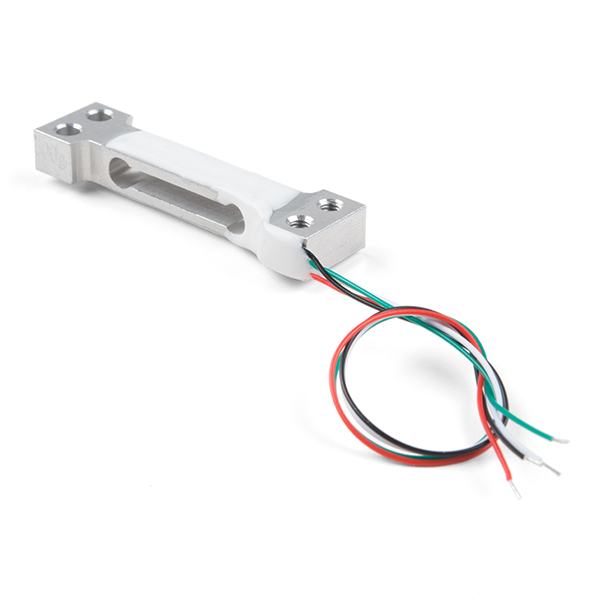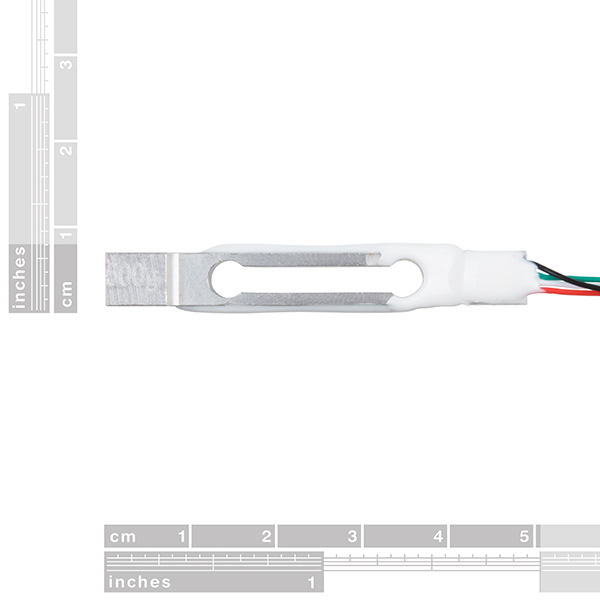Mini Load Cell - 500g, Straight Bar (TAL221)
This miniature straight bar load cell (sometimes called a strain gauge) can translate up to 500g of pressure (force) into an electrical signal. Each load cell is able to measure the electrical resistance that changes in response to, and proportional of, the strain (e.g. pressure or force) applied to the bar. With this gauge you will be able to tell just how heavy an object is, if an object's weight changes over time, or if you simply need to sense the presence of an object by measuring strain or load applied to a surface.
Each straight bar load cell is made from an aluminum-alloy and is capable of reading a capacity of 500g. These load cells have four strain gauges that are hooked up in a wheatstone bridge formation. The color code on the wiring is as follows: red = Exc+, green = Sig+, black = Exc-, and white = Sig-. Additionally, these load cells offer an IP65 protection rating and features four M3 sized through-holes for mounting purposes.
- Capacity: 500g
- Material: Aluminum-Alloy
- Parallel Beam Type
- IP65 Rating
- 47mm x 12mm x 6mm, 110mm Wire
Mini Load Cell - 500g, Straight Bar (TAL221) Product Help and Resources
OpenScale Applications and Hookup Guide
July 22, 2016
OpenScale allows you to have a permanent scale for industrial and biological applications. Learn how to use the OpenScale board to read and configure load cells.
Getting Started with Load Cells
June 11, 2015
A tutorial defining what a load cell is and how to use one.
Load Cell Amplifier HX711 Breakout Hookup Guide
July 22, 2016
A hookup guide for the HX711 load cell amplifier breakout board
Qwiic Scale Hookup Guide
April 11, 2019
Create your own digital scale quickly and easily using the Qwiic Scale!
Core Skill: Soldering
This skill defines how difficult the soldering is on a particular product. It might be a couple simple solder joints, or require special reflow tools.
Skill Level: Noob - Some basic soldering is required, but it is limited to a just a few pins, basic through-hole soldering, and couple (if any) polarized components. A basic soldering iron is all you should need.
See all skill levels
Core Skill: Electrical Prototyping
If it requires power, you need to know how much, what all the pins do, and how to hook it up. You may need to reference datasheets, schematics, and know the ins and outs of electronics.
Skill Level: Rookie - You may be required to know a bit more about the component, such as orientation, or how to hook it up, in addition to power requirements. You will need to understand polarized components.
See all skill levels
Comments
Looking for answers to technical questions?
We welcome your comments and suggestions below. However, if you are looking for solutions to technical questions please see our Technical Assistance page.
Customer Reviews
No reviews yet.



what is the mass of the sensor apparatus itself?
What is the resolution on this load cell when connected to the HX711 board? I need to be able to weigh 0.1 grams, and I would like the largest capacity I can find that will give that resolution.
The wires on these are very fragile. It doesn't take much manipulation and they break off at the load cell, rendering the load cell worthless. Until you find a way to improve the wire connections, I can't recommend these for experimentation. The 10kg ones are much more robust.
I am pretty sure the wires on both sensors are have the same gauge. That being said, you are correct, the sensor is designed to be in a static environment and should be handled with care.